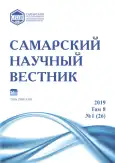Limits of seed germination of phytomeliorants under conditions of heavy metals toxic concentrations
- Authors: Oznobihina A.O.1
-
Affiliations:
- Tyumen Industrial University
- Issue: Vol 8, No 1 (2019)
- Pages: 82-86
- Section: 03.02.00 – General Biology
- URL: https://journals.rcsi.science/2309-4370/article/view/21586
- DOI: https://doi.org/10.17816/snv201981113
- ID: 21586
Cite item
Full Text
Abstract
The aim of the study is to conduct biological testing at the initial stages of plant objects viability in the model conditions of heavy metal pollution. The paper presents the results of laboratory experiments to assess the impact of different concentrations of heavy metal salts on the viability of yellow melilot and great trefoil seeds. In the course of the conducted experimental studies the author has been established a direct dependence of the decrease in the indices of germination energy and laboratory germination of seeds with an increase in the concentration of phytotoxicant salts, determined the critical (threshold) concentration of the studied elements and the metal content, in which the processes of growth and development of seeds remain. The concentration of 0,01% cadmium, zinc, lead and copper was optimal for germination of melilot seeds, where germination was equal to 80%, 74%, 69% and 64%, respectively. For great trefoil seeds, high germination rates were noted in case of 0,01% contamination with lead, zinc, cadmium and copper - 82%, 80%, 77% and 76%, respectively, and in 0,1% salt solution of lead, copper and zinc there were recorded 75%, 74% and 72% of seedlings. Zinc in the concentration of 0,01% at the initial stages of germination of phytomeliorant seeds stimulated germination energy. The tendency of resistance to pollution by lead, zinc and copper was observed at sprouts of a great trefoil, and to pollution by cadmium the greatest resistance was shown by a melilot yellow. Defining the limits of the leguminous plant seeds germination in the presence of a toxic agent will allow research and development in respect of biological restoration of contaminated soils and can be used in technologically disturbed lands.
Full Text
##article.viewOnOriginalSite##About the authors
Anastasia Olegovna Oznobihina
Tyumen Industrial University
Author for correspondence.
Email: n_a_s_t_y_a86@mail.ru
postgraduate student of Technosphere Safety Department
Russian Federation, TyumenReferences
- Ознобихина А.О., Скипин Л.Н., Котченко С.Г., Гаевая Е.В., Захарова Е.В. Особенности накопления тяжелых металлов в почвах северной лесостепи районов Тюменской области // Вестник КрасГАУ. 2018. № 5. С. 252-257.
- Гаевая Е.В., Захарова Е.В., Скипин Л.Н. Биогеохимия элементов в системе почва - растение - животное в условиях юга Тюменской области // Вестник КрасГАУ. 2013. № 11. С. 149-153.
- Наплекова Н.Н., Степанова М.Д. Биоиндикация загрязнения почв свинцом и кадмием по микробным ценозам. Новосибирск, 2000. 124 с.
- Ильин В.Б. Тяжелые металлы в системе почва - растение. Новосибирск: Наука, Сибирское отделение, 1991. 151 с.
- Кузнецов А.Е., Градова Н.Б., Лушников С.В., Энгельхарт М. Прикладная экобиотехнология: учеб. пособие для студентов. В 2 т. 2-е изд. (электронное). М.: Бином. Лаб. знаний, 2012.
- Боме Н.А., Белозерова А.А. Основы биотехнологии растений: учеб. пособие. Тюмень: Изд-во ТюмГУ, 2007. 92 с.
- Oznobihina A.O., Gayevaya E.V. Heavy Metals in Soil&Plant System Under Conditions of the South of Tyumen Region // IOP Conference Series: Materials Science and Engineering (MSE) International Conference on Construction, Architecture and Technosphere Safety, ICCATS 2017. Vol. 262. Chelyabinsk: South Ural State University, 2017. P. 012170.
- Савич В.И., Седых В.А., Никиточкин Д.Н., Сердюкова А.В., Шестаков А.К., Саидов Е.И. Агроэкологическая оценка состояния почв в системе почва - растение. М.: Изд-во ВНИИА, 2012. 360 с.
- Барсегян А.Г., Гендугов В.М., Глазунов Г.П. и др. Экологическое нормирование и управление качеством почв и земель. М.: НИА-Природа, 2013. 373 с.
- Глазовская М.А. Геохимия природных и техногенных ландшафтов. М.: Высшая школа, 1988. 328 с.
- Сысо А.И. Закономерности распределения химических элементов в почвообразующих породах и почвах Западной Сибири. Новосибирск: Изд-во СО РАН, 2007. 277 с.
- Муха В.Д., Картамышев Н.И., Муха Д.В. Агропочвоведение. М.: КолосС, 2004. С. 480-485.
- Черников В.А., Грингоф И.Г., Емцев В.Т. Агроэкология. Методология, технология, экономика. М.: КолосС, 2004. 400 с.
- Витол И.С. Экологические проблемы производства и потребления пищевых продуктов: учебное пособие. М.: Издательский комплекс МГУПП, 2000. 93 с.
- Давыдова С.Л., Тагасов В.И. Тяжелые металлы как супертоксиканты 21 века. М.: Изд-во РУДН, 2002. 140 с.
Supplementary files










